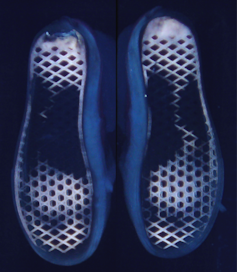Imagine the scene of a household burglary or murder where the criminals have left no other evidence than a series of footprints on the kitchen floor. If the perpetrators were caught, would the police have enough information to arrest and convict them, or would they simply be allowed to walk free? My colleagues and I have developed a new forensic imaging technique for analysing shoeprints that could help police to identify the criminal in such a situation.
How could a shoeprint be so useful to a criminal investigation? Clearly, it would not be nearly as effective for identifying a person as their DNA or fingerprints. Shoe soles are rarely unique and aren’t inherently connected to a suspect. But each person does have their own style of walking or moving, known as their gait. This is because we each distribute our weight differently when we walk and so we wear down our shoe soles in different ways. So if two individuals were to wear an identical type of shoe, then over time they would each wear them down differently.
It is these differences which police forensic services hope to exploit when they find shoeprint evidence at the scene of a serious crimes. The hope is that by matching contact images of shoe prints obtained in custody with marks found at crime scenes, police will rapidly be able to identify or eliminate suspects in their enquiries.
Collecting the evidence
The main method of getting forensic footwear evidence has, until now, involved collecting the shoeprint from the suspect’s footwear using vegetable dye-based ink pads and paper in a similar way to that used to take fingerprints. This approach has a number of disadvantages. First, the impressions obtained can often get quite smudged and are sometimes useless in identifying key features on the shoe soles.
These impressions then have to be scanned into digital form and transmitted to a forensic footwear specialist, who can then resize the image and manually compare it to photographs of shoeprints found at crime scenes. This is quite a time-consuming and laborious process that can take many hours.

To provide the police with a more accurate way of matching footprints, we have harnessed a technique called frustrated total internal reflection. Under normal conditions, light travelling through a piece of glass will be completely reflected when it hits the edge of the glass at the right angle. This is basically how optical fibres are used to transmit light signals over long distances. The light continues to bounce around inside the glass, creating a so-called waveguide, until it comes out of the other end of the fibre.
However, if certain materials are brought into contact with the surface of the glass, some of the light can leak out and be seen by an observer. If you place a shoe sole onto glass when total internal reflection is occurring inside it, the light that leaks out through the areas of contact is scattered by the sole and can easily be imaged using conventional digital cameras.
This simple technique is only sensitive to the areas where the shoe touches the surface of the glass, meaning it can be used to detect specific wear patterns or any marks or nicks in the shoe sole that may be clearly identifiable.
Money saving
In the UK, cuts to police budgets mean forensic services are being amalgamated and more efficient ways of analysing forensic evidence are required. These financial constraints are encouraging forensic science services to turn to digital methods of evidence gathering and to the increased automation of evidence processing.
The contact imaging technique that we have developed is entirely digital and will enable police to generate, transmit and compare contact images obtained in custody with those found at crime scenes via an online database. This will greatly reduce the time it takes to identify or eliminate suspects from ongoing investigations, saving the police valuable time and money.

